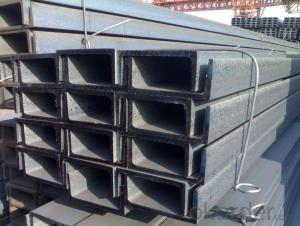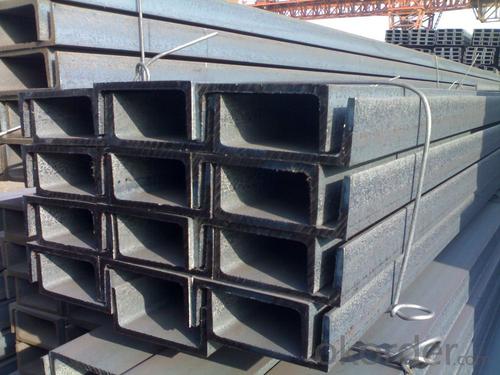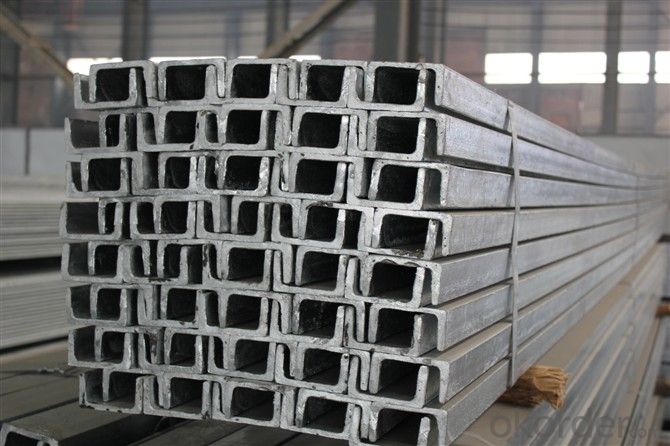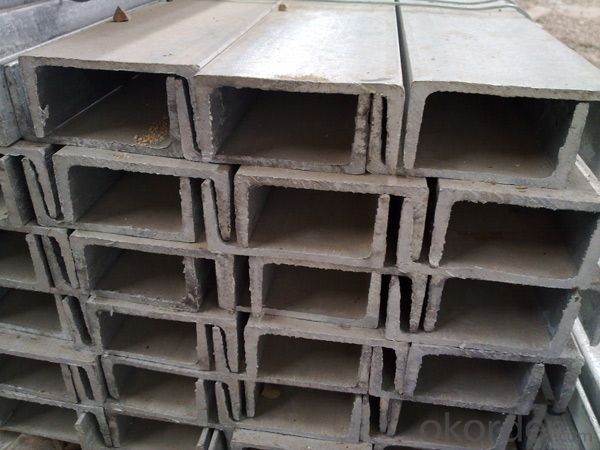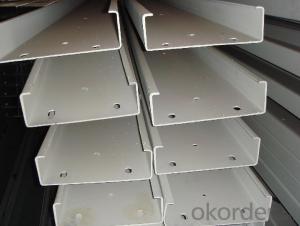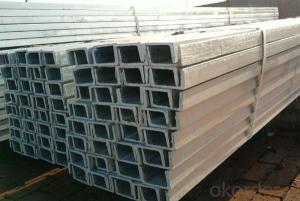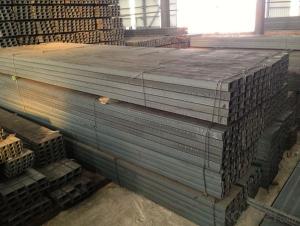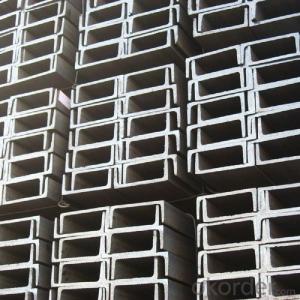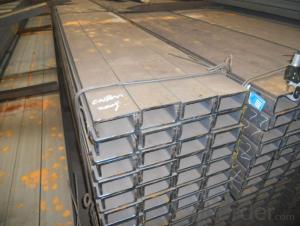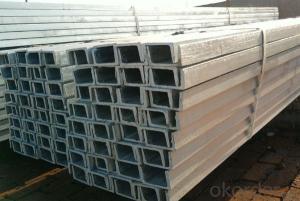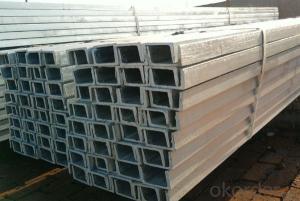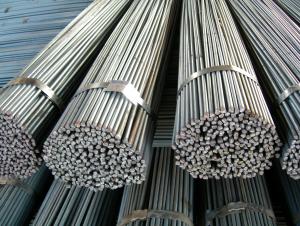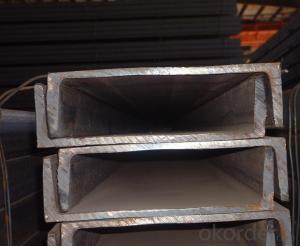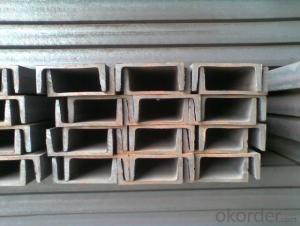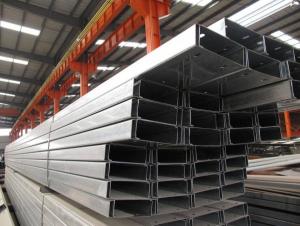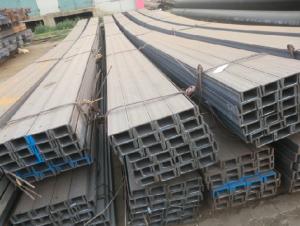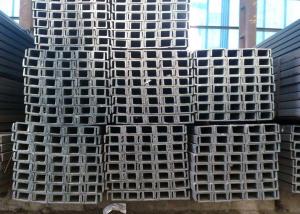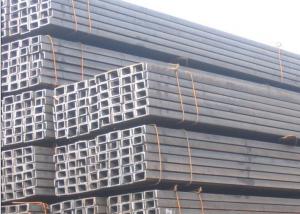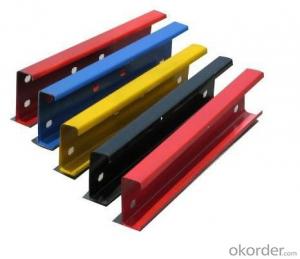U CHANNEL JIS SS400 High Quality Hot Rolled or GB
- Loading Port:
- China Main Port
- Payment Terms:
- TT or LC
- Min Order Qty:
- -
- Supply Capability:
- -
OKorder Service Pledge
OKorder Financial Service
You Might Also Like
Product Description:
OKorder is offering high quality U CHANNEL JIS SS400 High Quality Hot Rolled or GBat great prices with worldwide shipping. Our supplier is a world-class manufacturer of steel, with our products utilized the world over. OKorder annually supplies products to European, North American and Asian markets. We provide quotations within 24 hours of receiving an inquiry and guarantee competitive prices.
Product Applications:
1.The JIS U Channel Steel can be devided into two kinds, namely common channel steel and light channel steel. The sizes of hot rolled common channel steel range from 5# to 40#. Meanwhile, the channel steel can be divided into cold forming sectional equal channel steel, cold forming sectional unequal channel steel, cold forming inner edge channel steel and outer edge channel steel.
2.The JIS u channel steel is usually used for arch-itechtural structure, and they could be welded in order to support or hang a vari-ety of facilities. They are also usually used in combination with I beam. The channel steel with sizes under 14# is usually applied to construction engineering, as purline, while the channel steel with sizes above 16# is more likely to be used in building vehicle chassis structure and mechanical structure. Furthermore, the channel steel in sizes above 30# are target at building bridge structure, as tension bar.
3.In a word, the channel steel must possess perfect welding property, riveting property and mechanical property and so on.
Product Advantages:
OKorder's U CHANNEL JIS SS400 High Quality Hot Rolled or GBare durable, strong, and resist corrosion.
Main Product Features:
· Premium quality
· Prompt delivery & seaworthy packing (30 days after receiving deposit)
· Corrosion resistance
· Can be recycled and reused
· Mill test certification
· Professional Service
· Competitive pricing
Product Specifications:
Manufacture: Hot rolled
Grade: Q195 – 235
Certificates: ISO, SGS, BV, CIQ
Length: 6m – 12m, as per customer request
Packaging: Export packing, nude packing, bundled
Original Place | Tangshan, China | Brand Name | UINDA |
Standard | JIS G3192 : 1990 | ||
Material Grade | SS490 | ||
Sizes | 50mm to 200mm | ||
Sales Volume/Year | 3000MT | ||
Destination Area | Middle East, Africa, Southeast Asia | ||
2. The sections in details are as followings in the table-1
JIS U CHANNEL | Standard | Sectional | Dimension |
| Mass: |
| (mm) | (mm) | (mm) | (mm) |
|
50x25 | 50 | 25 | 3.0 | 6.00 | 2.37 |
75X40 | 75 | 40 | 3.8 | 7.00 | 5.30 |
75X40 | 75 | 40 | 4.0 | 7.00 | 5.60 |
75X40 | 75 | 40 | 4.5 | 7.00 | 5.85 |
75X40 | 75 | 40 | 5.0 | 7.00 | 6.92 |
|
|
|
|
|
|
100X50 | 100 | 50 | 3.8 | 6.00 | 7.30 |
100X50 | 100 | 50 | 4.2 | 6.00 | 8.03 |
100X50 | 100 | 50 | 4.5 | 7.50 | 8.97 |
100X50 | 100 | 50 | 5.0 | 7.50 | 9.36 |
|
|
|
|
|
|
125X65 | 125 | 65 | 5.2 | 6.80 | 11.66 |
125X65 | 125 | 65 | 5.3 | 6.80 | 12.17 |
125X65 | 125 | 65 | 5.5 | 8.00 | 12.91 |
125X65 | 125 | 65 | 6.0 | 8.00 | 13.40 |
|
|
|
|
|
|
150x75 | 150 | 75 | 5.5 | 7.30 | 14.66 |
150x75 | 150 | 75 | 5.7 | 10.00 | 16.71 |
150x75 | 150 | 75 | 6.0 | 10.00 | 17.90 |
150x75 | 150 | 75 | 6.5 | 10.00 | 18.60 |
150x75 | 150 | 75 | 6.5 | 10.00 | 24.00 |
|
|
|
|
|
|
200X80 | 200 | 80 | 7.5 | 11.00 | 24.60 |
3. The mechanical property of JIS U Channel Steel in the table-2:
Grade | Yield Strength,N/mm² | Extension Strength N/mm² | |||
Thickness of Steel,mm | |||||
≦16 | >16-≦40 | >40-≦100 | >100 | ||
SS490 | ≧285 | ≧275 | ≧255 | ≧245 | 490-610 |
4. The chemical composition of JIS U Channel Steel as per SS490 in the table-3
Grade | Element(%) | |||
C | Mn | P | S | |
SS490 | - | - | ≦0.050 | ≦0.050 |
FAQ:
Q1: Why buy Materials & Equipment from OKorder.com?
A1: All products offered byOKorder.com are carefully selected from China's most reliable manufacturing enterprises. Through its ISO certifications, OKorder.com adheres to the highest standards and a commitment to supply chain safety and customer satisfaction.
Q2: How do we guarantee the quality of our products?
A2: We have established an advanced quality management system which conducts strict quality tests at every step, from raw materials to the final product. At the same time, we provide extensive follow-up service assurances as required.
Q3: The products are invoicing on theoritical weight or on actual weight?
A3: We can do it in both manners, according to the customers' request.
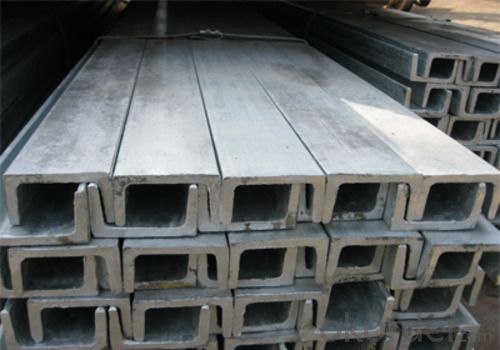
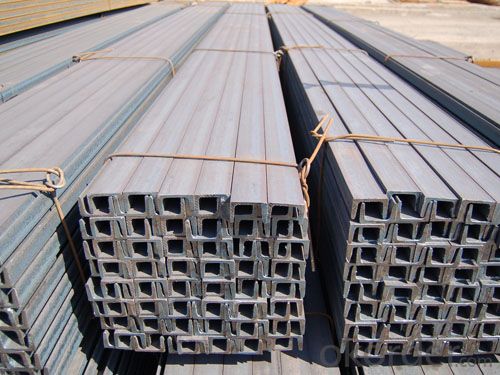
- Q: How do steel channels contribute to the overall safety of a structure?
- There are several ways in which steel channels contribute to the overall safety of a structure. To begin with, steel channels provide structural support and stability to the building. In the construction industry, they are commonly utilized as load-bearing members. This aids in the efficient and even distribution of the structure's weight. As a result, the building can withstand external forces like wind, earthquakes, and heavy loads without collapsing. The presence of steel channels creates a robust framework that enhances the building's overall safety and structural integrity. Moreover, steel channels play a critical role in fire safety. Steel is a non-combustible material, and when used as channels, it effectively prevents the spread of fire within the structure. In the event of a fire, steel channels act as fire barriers, limiting the movement of flames and heat to specific areas. This containment of fire helps minimize damage and provides occupants with more time to evacuate safely. Furthermore, steel channels exhibit exceptional resistance to corrosion and deterioration, making them highly durable and reliable. Unlike other materials, steel does not decay, distort, or degrade over time. This longevity ensures that the structure remains stable and secure in the long term, reducing the risk of accidents and structural failures. Additionally, steel channels are frequently utilized in the construction of seismic-resistant structures. Their impressive strength and flexibility allow them to absorb and dissipate seismic energy during earthquakes. This ability to withstand seismic forces helps to minimize structural damage and ensures the safety of the building's occupants. In conclusion, steel channels contribute significantly to the overall safety of a structure by providing structural support, fire resistance, durability, and seismic resistance. Their inclusion in construction enhances the stability, strength, and integrity of the building, guaranteeing the safety and well-being of its occupants.
- Q: Are steel channels suitable for use in storage racks?
- Yes, steel channels are suitable for use in storage racks. Steel channels are designed to provide structural support and strength, making them ideal for storing heavy items or materials on racks. They offer high load-bearing capacity, durability, and resistance to bending or warping, which ensures the stability and safety of the storage racks. Moreover, steel channels can be easily customized and adjusted to fit specific storage requirements, making them versatile for various storage applications. Overall, steel channels are a reliable and efficient choice for constructing storage racks.
- Q: How do steel channels contribute to the overall safety of a structure during earthquakes?
- Steel channels play a vital role in enhancing the safety of structures during earthquakes due to their ability to provide stability and strength. They are commonly used as components in the structural system to distribute and transfer loads. When an earthquake occurs, these channels act as load-bearing members, effectively absorbing and dispersing the seismic forces to prevent localized damage. The shape and form of steel channels enable them to resist lateral forces and offer resistance against bending and twisting motions caused by seismic waves. By evenly distributing the forces throughout the structure, steel channels help prevent concentrated stress points that could potentially lead to structural failure. Moreover, steel channels are highly durable and resistant to damage, making them ideal for earthquake-prone areas. Their strength-to-weight ratio allows for the construction of lighter yet robust structures. This reduces the overall mass of the building, which in turn decreases the inertia forces generated during an earthquake and minimizes the likelihood of structural collapse. Additionally, steel channels can be integrated into seismic design strategies such as moment resisting frames or braced frames. These systems provide additional rigidity and stiffness to the structure, ensuring its ability to withstand the lateral forces exerted by an earthquake. The flexibility of steel channels also allows for the absorption of energy, thus reducing the impact on the overall structure. In conclusion, steel channels contribute significantly to the safety of structures during earthquakes by providing stability, distributing seismic forces, resisting bending and twisting motions, and reducing mass and inertia forces. Their durability, strength, and energy absorption capabilities make them an essential component in earthquake-resistant design strategies.
- Q: What kind of high strength steel and square steel
- Of course, the same thickness 6 high strength.
- Q: What are the different methods for connecting steel channels?
- There exist various techniques for connecting steel channels, each with its own benefits and uses. Some commonly employed methods comprise: 1. Welding: A prevalent approach for joining steel channels is welding. This process involves melting the adjacent surfaces and fusing them together using a compatible filler material. Welding produces a durable and everlasting connection, rendering it suitable for structural purposes. 2. Bolting: Another method involves utilizing bolts, nuts, and washers to connect steel channels. Bolting is comparatively simpler and faster than welding. It offers a flexible connection, allowing for disassembly and reassembly when necessary. This technique is often employed in applications requiring frequent maintenance or adjustments. 3. Riveting: Riveting is a technique that utilizes cylindrical metal pins called rivets to connect steel channels. These rivets are inserted through pre-drilled holes in the channels and then hammered or compressed to secure them in place. Riveting establishes a robust and dependable connection, commonly found in heavy-duty applications. 4. Adhesive bonding: Adhesive bonding involves using specialized adhesives to join steel channels. This method creates a strong bond and is especially useful in situations where welding or bolting may not be practical or desirable. Adhesive bonding can also help evenly distribute loads across the joint, reducing stress concentrations. 5. Mechanical connectors: Mechanical connectors, such as beam clamps or connectors with threaded rods, are employed to connect steel channels in applications requiring adjustability or reconfigurability. These connectors facilitate easy installation and provide a secure connection without the need for welding or drilling. To ensure the appropriate method is selected for a specific application, factors such as load-bearing requirements, structural integrity, ease of installation, disassembly, and future maintenance considerations must be taken into account. Seeking the guidance of a structural engineer or adhering to established codes and standards can assist in making the suitable choice.
- Q: Can steel channels be used in the telecommunications industry?
- Yes, steel channels can be used in the telecommunications industry. Steel channels are commonly used as cable trays and support systems for telecommunications cables. They provide a sturdy framework for routing and organizing cables, ensuring proper cable management and preventing damage. Additionally, steel channels are known for their durability and strength, making them suitable for withstanding the weight of heavy cables and equipment. They can also be easily customized and modified to accommodate specific requirements in the telecommunications industry. Overall, steel channels offer a reliable and cost-effective solution for cable management in the telecommunications sector.
- Q: Can steel channels be used in railway and transportation infrastructure?
- Yes, steel channels can be used in railway and transportation infrastructure. Steel channels are commonly used in the construction of railway tracks, bridges, and other transportation structures due to their high strength and durability. They provide structural support and stability to the infrastructure, ensuring safe and reliable transportation. Steel channels also offer resistance to heavy loads, corrosion, and extreme weather conditions, making them suitable for use in railway and transportation projects. Additionally, steel channels can be easily fabricated and installed, allowing for efficient construction and maintenance of the infrastructure. Overall, steel channels are a preferred choice in railway and transportation infrastructure due to their excellent mechanical properties and long-term performance.
- Q: How do steel channels perform in acoustic applications?
- Due to their structural properties, steel channels are effective in acoustic applications. The rigidity and strength of steel make it an ideal material for sound barriers and vibration minimization. Constructing walls, partitions, or ceilings with steel channels can help isolate sound and prevent transmission. The dense nature of steel aids in absorbing and dampening sound waves, reducing intensity and preventing reverberation. This is particularly advantageous in noise-sensitive environments like recording studios, theaters, or conference rooms. Additionally, steel channels can be combined with soundproofing materials or insulation to improve their acoustic performance. Adding layers of foam, fiberglass, or acoustic panels to the steel channels further reduces sound transmission and enhances overall acoustic quality. Furthermore, steel channels provide stability and durability, ensuring the integrity of acoustic structures over time. They can withstand heavy loads and offer fire resistance, making them a reliable choice for acoustic applications. However, it is important to note that steel channels alone may not be sufficient for soundproofing in high-noise environments. The effectiveness of steel channels in acoustic applications also depends on factors like space design, construction quality, and the use of additional soundproofing techniques. In conclusion, steel channels play a valuable role in achieving sound control and acoustic performance in various applications. Their strength, rigidity, and sound-dampening abilities make them suitable for creating sound barriers and minimizing noise transmission.
- Q: Can steel channels be used in modular construction?
- Yes, steel channels can be used in modular construction. Steel channels are commonly used as structural components in modular construction due to their strength, durability, and versatility. They provide excellent support and stability to modular buildings, ensuring that they can withstand various loads and environmental conditions. Additionally, steel channels can be easily fabricated and assembled, making them suitable for the fast and efficient construction process required in modular construction. Overall, steel channels are a reliable and efficient choice for modular construction projects.
- Q: The role of channel?
- Channel steel is used in building construction and vehicle manufacture, including hot rolled channel steel and bent channel steel. Hot rolled channel steel can be divided into two types: ordinary and light. The channel steel specifications are from 5 to 40, i.e., the corresponding height is 5 to 40cm. At the same height, the light channel steel has narrower legs, thinner waist and lighter weight than ordinary channel steel. Channel steel is widely used in the manufacture of vehicles and various metal structures.
Send your message to us
U CHANNEL JIS SS400 High Quality Hot Rolled or GB
- Loading Port:
- China Main Port
- Payment Terms:
- TT or LC
- Min Order Qty:
- -
- Supply Capability:
- -
OKorder Service Pledge
OKorder Financial Service
Similar products
Hot products
Hot Searches
Related keywords
